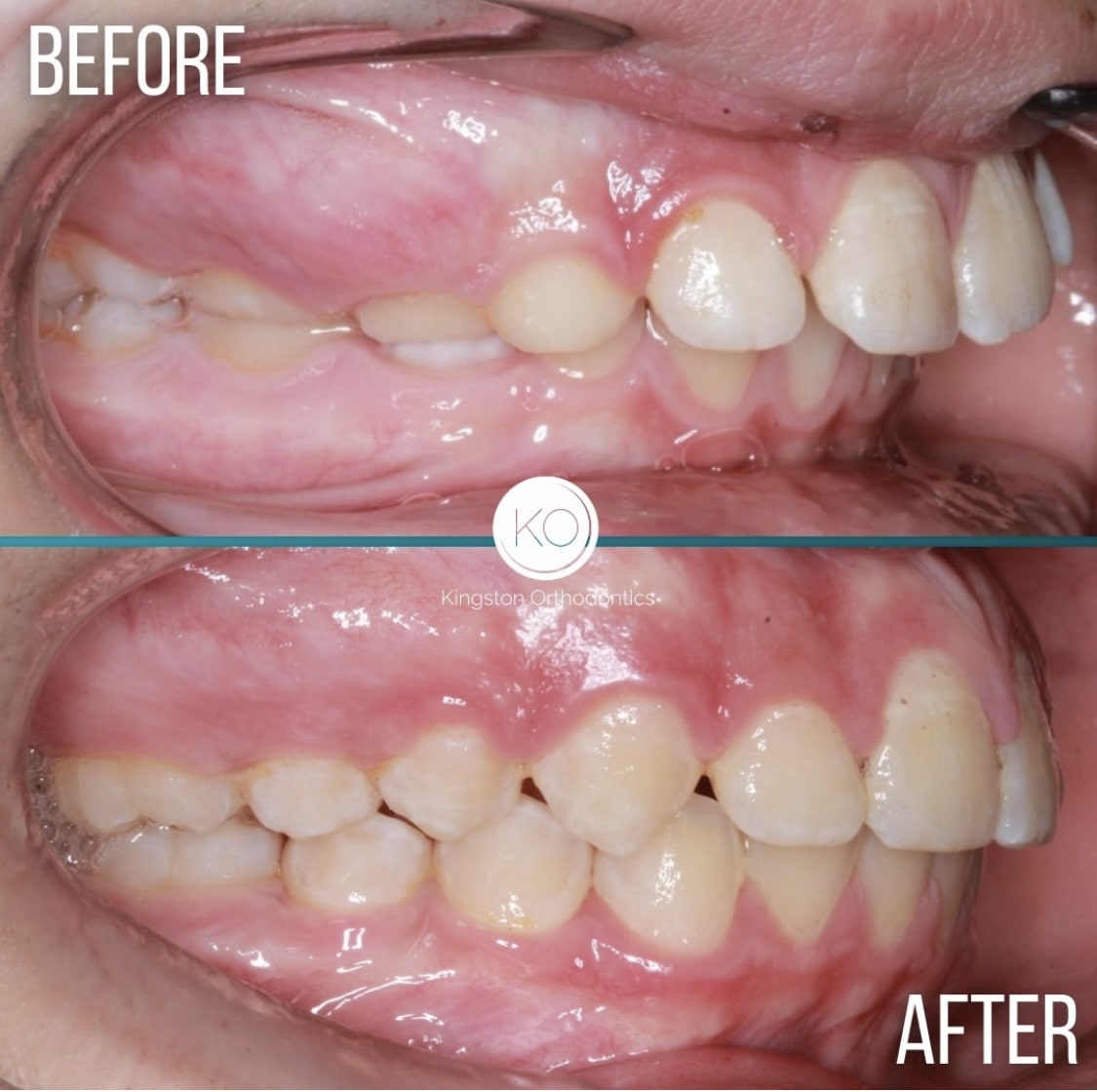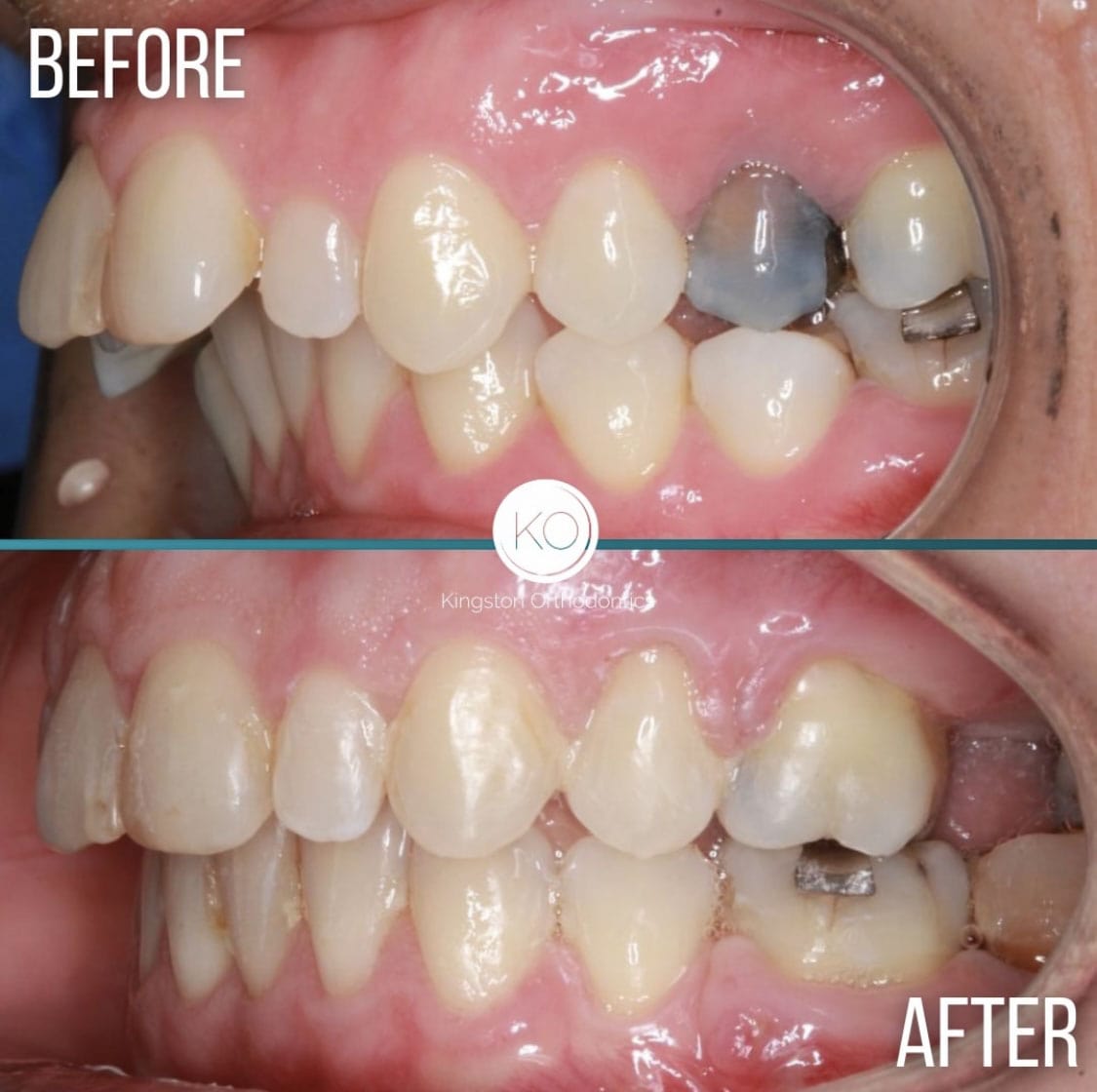
How do braces correct overbites
Approximately 20% of the population have an “overbite” which is known in orthodontic terminology as an overjet. It is normal for the upper incisors to be in front of the lower incisors by 2-4mm, patients become aware of an overbite once this measurement increases and particularly when it is more than 9mm.
How does an overbite develop and how can it be corrected by an orthodontist?
Overbites have two main causes, a dental cause and/or a skeletal cause. Orthodontists begin by establishing the cause of the overbite then plan the ideal treatment needed.



Dental Overbites
A dental overbite is when the upper and lower jaw position is correct but the upper teeth project too far forward; the lower teeth may also lean back too far which adds to the size of the gap between the upper and lower front teeth.
Common reasons for dental overbites are prolonged dummy use, thumb or finger sucking habits and when the lower lip is trapped behind the upper teeth. Top teeth can also project further forward when they are overlapping and crowded.
Due to the lack of jaw problems in these cases, braces alone can be used to correct dental overbites.



Correction of dental overbites
Fixed braces or Invisalign aligners can be used to correct mild to moderate overbites by moving the teeth only.
Fixed brace options include traditional metal fixed braces that have the most visibility but are very effective or more discreet fixed braces such as ceramic braces, Iconix fixed braces or lingual fixed braces.
Iconix fixed braces are metal braces with a light gold coating that has a less harsh appearance compared to metal braces.
Ceramic fixed braces are a very popular brace choice for adults who are keen to have the effectiveness of a fixed brace with a more subtle appearance.
Lingual fixed braces are bonded to the inner surface of the teeth thereby making them completely invisible on speaking and smiling.
Invisalign aligners are removable clear trays that incrementally move the teeth. Attachments are bonded to the surfaces of several teeth to provide anchor points and enable movement. Attachments are made of tooth coloured composite material that is bonded to the outer surface of the teeth. The attachments remain on the teeth with the aligners are removed on a daily basis. Once the Invisalign treatment is complete then the attachments are carefully removed.
The orthodontist will discuss the advantages and disadvantages of each system as well as the need for elastic bands to be worn from the upper brace at the front to the lower brace at the back. The elastics help to tip the upper teeth back and the lower teeth forward to correct the overbite.
In moderate overbite cases, there may be a need to remove adult teeth to then allow the upper teeth to be moved backwards to reduce the prominence of the upper teeth. For those with moderate overbites who do not want to have extractions, a compromise may have to be accepted and there may still be an increased overbite at the end of orthodontic treatment.



Skeletal Overbites
A skeletal overbite is due to a mismatch between the size of the upper and lower jaw. In most cases the lower jaw and chin are smaller and set back which gives the appearance of prominent upper teeth. A set back lower jaw may also result in other associated conditions such as sleep apnoea as the lower jaw and therefore the tongue position both restrict the airway and interfere with breathing when asleep.
Full correction of a skeletal overbite involves a combination of braces and jaw surgery to lengthen the lower jaw and correct the chin position. This type of surgery is known as orthognathic surgery and is jointly planned and carried out by a Consultant orthodontist and Consultant maxillofacial surgeon.
Patients who opt for surgical correction initially have fixed braces for 12 – 18 months to fully align the upper teeth and lower teeth; this can often exaggerate the size of the overbite pre surgery. The braces then remain in place during surgery as well as for 6-9 months after surgery to ensure that the bite is ideal.
A large proportion of adults with a skeletal overbite are not concerned enough to consider jaw surgery and may only want to have orthodontic treatment with braces to camouflage the overbite as much as possible whilst maintaining the jaw size discrepancy. When the jaw size difference is extensive, the option of braces only to camouflage the overbite may not be possible.



Correction of skeletal overbites
In a growing child, growth modification is possible with a functional appliance that alters the direction of growth of the lower jaw and tips the upper teeth back and the lowers forward.
A removable functional appliance such as a Twin Block is commonly used to achieve these movements. Invisalign aligners also have a mandibular advancement option called Invisalign MA that aims to achieve the same growth modification and tooth movements but has the advantage of being less bulky than a Twin Block.
Once growth has ceased then the option of growth modification is no longer feasible and the only treatment options available are either orthodontic braces to camouflage the skeletal overbite or braces combined with jaw surgery to achieve the ideal tooth position, jaw position and bite.



Maintaining the orthodontic result
Once active treatment of dental or skeletal overbites is achieved, retainers are then needed to maintain the alignment of the teeth and the bite.
A fixed bonded retainer is a wire that is bonded on the inner surface of the upper and lower front teeth to hold them in position. A removable clear retainer is also constructed for nightly wear. Having both retainers in place limits the amount of relapse that can occur over the years.











